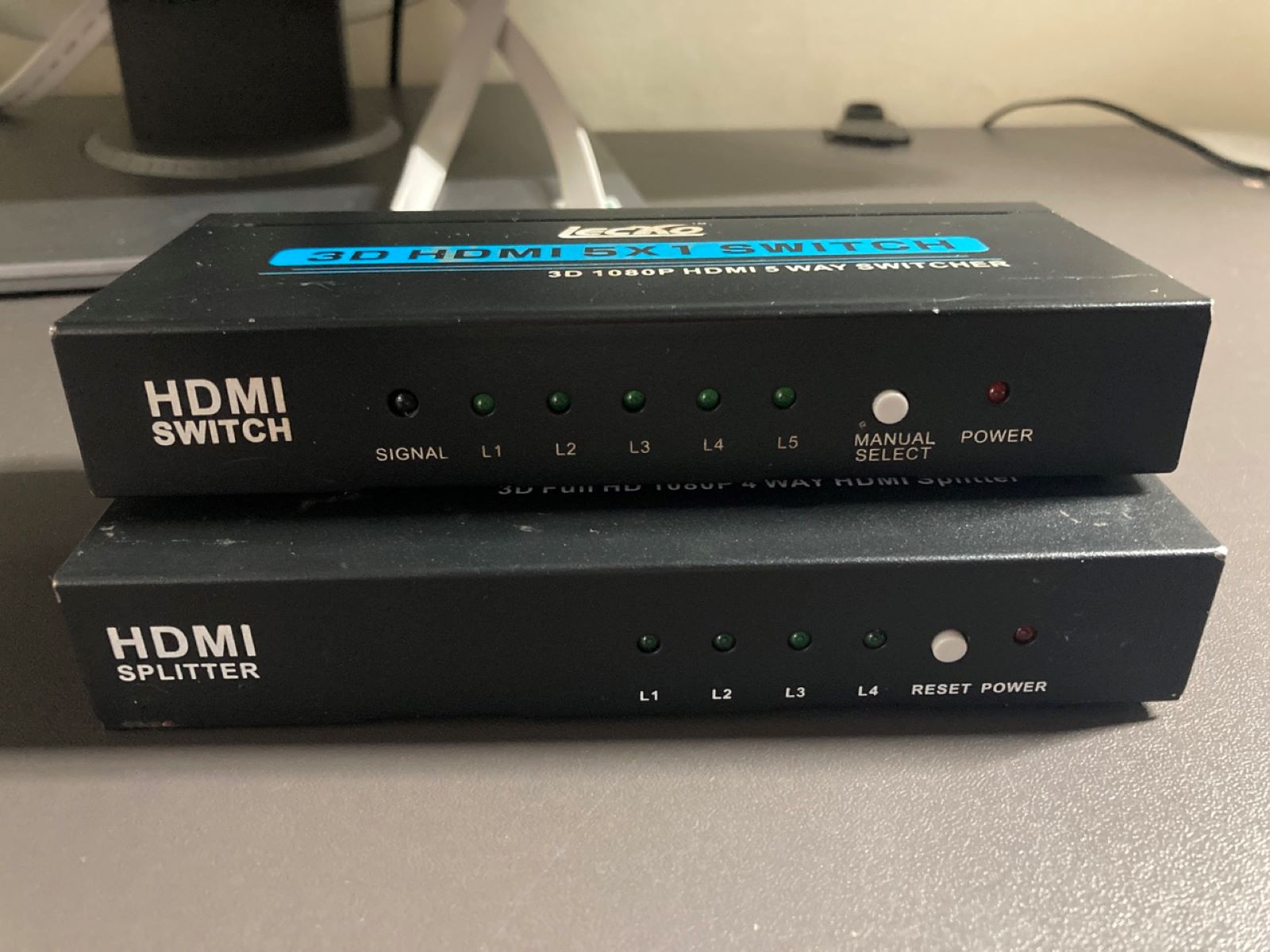Home>Technology and Computers>The Key Difference Between HDMI Splitters And HDMI Switches


Technology and Computers
The Key Difference Between HDMI Splitters And HDMI Switches
Published: February 3, 2024
Learn the key differences between HDMI splitters and HDMI switches in the world of technology and computers. Understand which device is best for your specific needs.
(Many of the links in this article redirect to a specific reviewed product. Your purchase of these products through affiliate links helps to generate commission for Regretless.com, at no extra cost. Learn more)
Table of Contents
Introduction
In the realm of home entertainment systems and professional audiovisual setups, the need to connect multiple devices to a single display or projector is a common challenge. This is where HDMI splitters and HDMI switches come into play. These two devices serve distinct purposes, yet their names can often cause confusion. Understanding the key differences between HDMI splitters and HDMI switches is essential for anyone seeking to optimize their audiovisual setup.
HDMI, which stands for High-Definition Multimedia Interface, has become the standard for transmitting high-quality audio and video signals between devices. An HDMI splitter and an HDMI switch are both designed to manage HDMI signals, but they do so in different ways to address distinct requirements.
As the demand for larger displays and more sophisticated audiovisual setups continues to grow, the significance of these devices becomes increasingly apparent. Whether you are a home theater enthusiast, a gaming aficionado, or a professional in the audiovisual industry, grasping the nuances of HDMI splitters and switches can greatly enhance your viewing and listening experiences.
In this article, we will delve into the intricacies of HDMI splitters and HDMI switches, shedding light on their unique functionalities and use cases. By the end, you will have a comprehensive understanding of how these devices differ and the factors to consider when choosing between them. So, let's embark on this enlightening exploration into the world of HDMI splitters and switches.
What is an HDMI Splitter?
An HDMI splitter is a device that takes a single High-Definition Multimedia Interface (HDMI) input and replicates it to multiple HDMI outputs. This means that a single source, such as a Blu-ray player, gaming console, or cable box, can be connected to an HDMI splitter, which then distributes the signal to multiple displays or other HDMI-enabled devices simultaneously.
The primary function of an HDMI splitter is to overcome the limitation of a single HDMI port on a source device, allowing the same audio and video signal to be displayed on multiple screens or projectors. This is particularly useful in scenarios where content needs to be mirrored across several displays, such as in a retail store, conference room, or home theater setup.
HDMI splitters come in various configurations, supporting different numbers of outputs, ranging from two to as many as sixteen or more. Some splitters also offer advanced features such as signal amplification to ensure consistent signal strength across all outputs, and support for resolutions up to 4K Ultra High Definition (UHD) and High Dynamic Range (HDR) content.
One common application of HDMI splitters is in home entertainment systems, where a single cable box or media player can be connected to distribute content to multiple televisions in different rooms. This allows everyone in the household to enjoy the same content simultaneously, without the need for separate cable boxes or media players for each TV.
In professional settings, HDMI splitters are often used in conference rooms, trade show booths, and digital signage installations to showcase the same content on multiple displays, ensuring that everyone in the audience has a clear view of the presentation or promotional material.
Overall, an HDMI splitter serves as a practical solution for distributing HDMI signals across multiple displays, making it a valuable tool for both personal and professional audiovisual setups. Understanding its capabilities and limitations is crucial when evaluating whether an HDMI splitter is the right device for a specific audiovisual requirement.
What is an HDMI Switch?
An HDMI switch is a device designed to address the challenge of connecting multiple HDMI source devices, such as gaming consoles, Blu-ray players, streaming devices, and cable boxes, to a single HDMI display or projector. It allows users to expand the number of HDMI inputs available on their TV or monitor, thereby enabling seamless switching between different sources.
The primary function of an HDMI switch is to eliminate the need for constantly swapping HDMI cables between devices, providing a convenient and efficient way to manage multiple HDMI sources. With an HDMI switch, users can connect several HDMI devices to the switch, which is then connected to a single HDMI input on the display or projector. This enables users to effortlessly switch between devices without the hassle of physically connecting and disconnecting cables.
HDMI switches come in various configurations, offering different numbers of inputs, typically ranging from two to as many as eight or more. Some advanced HDMI switches support features such as automatic switching, remote control operation, and support for high-resolution formats including 4K Ultra High Definition (UHD) and High Dynamic Range (HDR) content.
In a home entertainment setup, an HDMI switch can be a game-changer, especially for enthusiasts with multiple HDMI source devices. For example, a user may have a gaming console, a Blu-ray player, and a streaming device, all of which need to be connected to a single TV. Instead of constantly swapping cables, an HDMI switch allows for seamless transitions between these devices, enhancing the overall user experience.
In professional environments, HDMI switches are utilized in conference rooms, control centers, and multimedia production setups where multiple HDMI sources need to be seamlessly integrated with a single display or projector. This ensures that presenters, operators, or content creators can effortlessly switch between different sources without disruption.
Overall, an HDMI switch provides a practical solution for managing multiple HDMI source devices, offering convenience, flexibility, and enhanced connectivity for both personal and professional audiovisual setups. Understanding the capabilities and features of HDMI switches is essential for determining whether a switch is the right solution for a specific audiovisual requirement.
Key Differences Between HDMI Splitters and HDMI Switches
Understanding the key differences between HDMI splitters and HDMI switches is crucial for making informed decisions when it comes to managing audiovisual setups. While both devices are designed to handle HDMI signals, they serve distinct purposes and cater to different requirements. Here are the fundamental differences between HDMI splitters and HDMI switches:
-
Signal Distribution: The primary distinction lies in how these devices handle HDMI signals. An HDMI splitter takes a single HDMI input and replicates it to multiple outputs, allowing the same audio and video signal to be displayed across multiple displays or devices simultaneously. On the other hand, an HDMI switch enables users to connect multiple HDMI source devices to a single display, providing the ability to switch between different sources seamlessly.
-
Purpose: HDMI splitters are ideal for scenarios where the same content needs to be displayed on multiple screens or projectors simultaneously. This is commonly seen in retail environments, conference rooms, and home entertainment setups where mirroring content across multiple displays is essential. In contrast, HDMI switches are designed to address the challenge of connecting multiple HDMI source devices to a single display, offering a convenient way to manage and switch between different sources without constantly swapping cables.
-
Functionality: HDMI splitters excel at distributing content from a single source to multiple displays, making them suitable for applications where content mirroring is required. They are particularly useful in scenarios where the same content needs to be showcased across multiple screens, such as in digital signage installations or home theater setups. On the other hand, HDMI switches provide the flexibility to connect and switch between multiple HDMI source devices, offering convenience and efficient management of various audiovisual sources.
-
Number of Connections: Another key difference lies in the number of connections each device supports. HDMI splitters are designed to replicate a single input to multiple outputs, with configurations ranging from two to multiple outputs, depending on the specific model. In contrast, HDMI switches offer multiple inputs to a single output, allowing users to connect and switch between several source devices using a single display or projector.
-
User Experience: The user experience differs significantly between HDMI splitters and HDMI switches. HDMI splitters cater to scenarios where content needs to be mirrored across multiple displays, ensuring a consistent viewing experience across all connected devices. On the other hand, HDMI switches enhance user convenience by providing a seamless way to switch between different HDMI source devices, eliminating the need for manual cable swapping and streamlining the overall audiovisual experience.
In summary, the key differences between HDMI splitters and HDMI switches revolve around their core functionalities, purposes, and the manner in which they handle HDMI signals. Understanding these distinctions is essential for selecting the right device to meet specific audiovisual requirements, whether for personal entertainment setups or professional audiovisual installations.
Factors to Consider When Choosing Between an HDMI Splitter and an HDMI Switch
When faced with the decision of whether to invest in an HDMI splitter or an HDMI switch, several factors come into play. Understanding these considerations is essential for making an informed choice that aligns with specific audiovisual requirements. Here are the key factors to consider when evaluating the suitability of an HDMI splitter or an HDMI switch:
-
Audiovisual Setup Requirements: The first step in the decision-making process is to assess the specific needs of the audiovisual setup. If the goal is to display the same content across multiple screens or projectors simultaneously, an HDMI splitter is the ideal choice. Conversely, if there is a need to connect and seamlessly switch between multiple HDMI source devices using a single display or projector, an HDMI switch would be more suitable.
-
Number of HDMI Inputs and Outputs: Evaluating the number of HDMI source devices and displays involved in the setup is crucial. For scenarios where a single source needs to be distributed to multiple displays, the number of outputs supported by the HDMI splitter becomes a critical consideration. Similarly, in setups with multiple HDMI source devices, the number of inputs provided by the HDMI switch will determine its compatibility with the existing devices.
-
Resolution and Signal Compatibility: It's essential to ensure that the chosen device supports the desired resolution and signal formats. For instance, if the setup involves 4K Ultra High Definition (UHD) content or High Dynamic Range (HDR) signals, selecting an HDMI splitter or switch with the appropriate signal compatibility becomes paramount to delivering a high-quality viewing experience.
-
User Experience and Convenience: Consider the user experience implications of each device. If the goal is to simplify the management of multiple HDMI source devices and provide seamless switching capabilities, an HDMI switch may offer a more convenient solution. Conversely, if the priority is to ensure consistent content display across multiple screens without the need for manual intervention, an HDMI splitter would be the preferred choice.
-
Future Expansion and Scalability: Anticipating future needs and scalability is essential, especially in dynamic audiovisual environments. Assessing the potential for expanding the setup with additional HDMI source devices or displays can influence the decision between an HDMI splitter and an HDMI switch. Selecting a device that accommodates future expansion can contribute to long-term flexibility and cost-effectiveness.
-
Advanced Features and Functionality: Explore the additional features offered by HDMI splitters and switches, such as signal amplification, remote control operation, automatic switching, and compatibility with audio formats. These advanced functionalities can enhance the overall performance and user experience, providing added value to the chosen device.
By carefully considering these factors, individuals and professionals can make well-informed decisions when choosing between an HDMI splitter and an HDMI switch. Each factor plays a crucial role in determining the most suitable device for a specific audiovisual setup, ensuring seamless connectivity, optimal performance, and an enhanced viewing experience.
Conclusion
In conclusion, the distinction between HDMI splitters and HDMI switches lies in their fundamental functionalities and the specific audiovisual requirements they address. An HDMI splitter excels at distributing a single HDMI input to multiple outputs, making it an ideal choice for scenarios where mirroring content across multiple displays or devices is essential. On the other hand, an HDMI switch provides the convenience of connecting and seamlessly switching between multiple HDMI source devices using a single display or projector, streamlining the management of diverse audiovisual sources.
When considering whether to invest in an HDMI splitter or an HDMI switch, several factors come into play, including the specific needs of the audiovisual setup, the number of HDMI inputs and outputs required, signal compatibility, user experience considerations, future expansion potential, and the availability of advanced features. By carefully evaluating these factors, individuals and professionals can make informed decisions that align with their unique audiovisual requirements, ensuring optimal performance and an enhanced viewing experience.
The versatility and practicality of HDMI splitters and switches make them indispensable tools in a wide range of environments, including home entertainment systems, professional audiovisual installations, conference rooms, trade show booths, and digital signage setups. Whether it's ensuring consistent content display across multiple screens, simplifying the management of multiple HDMI source devices, or accommodating future expansion, the right choice between an HDMI splitter and an HDMI switch can significantly impact the efficiency and user experience of an audiovisual setup.
As technology continues to evolve and the demand for immersive audiovisual experiences grows, the role of HDMI splitters and switches becomes increasingly significant. These devices not only streamline connectivity and signal management but also contribute to the seamless integration of diverse audiovisual sources, ultimately enhancing the way we interact with and consume digital content.
In essence, the understanding of HDMI splitters and switches, along with the considerations involved in choosing the right device, empowers individuals and professionals to optimize their audiovisual setups, unlocking the full potential of their entertainment systems and professional installations. By embracing the capabilities of these devices, users can elevate their viewing and listening experiences while embracing the versatility and convenience offered by HDMI splitters and switches.














